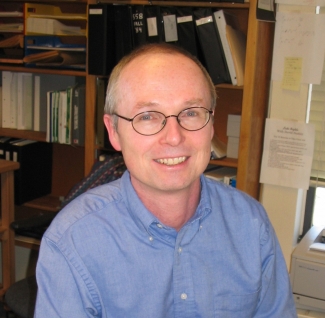The American Chemical Society (ACS) has awarded David Nesbitt the 2017 E. Bright Wilson Award in Spectroscopy. The award, sponsored by the ACS Division of Physical Chemistry, recognizes outstanding accomplishments in fundamental or applied spectroscopy in chemistry. It consists of $5,000 and a certificate.
Nesbitt will be honored at an awards ceremony on April 4, 2017, held in conjunction with the 253rd ACS National Meeting in San Francisco. There, he will deliver an award address at the spring awards symposium of the ACS Division of Physical Chemistry. Nesbitt was particularly pleased to be honored with this award.
“Spectroscopy is the way we speak to the Universe, and the way the Universe speaks to us,” Nesbitt said. He added that E. B. Wilson was not only a great pioneer of spectroscopy at Harvard, but also a genuinely nice man. “He was a brilliant scholar with a gentle personality; no one’s ever said a bad word about E.B.”
Nesbitt explained that the E. Bright Wilson Award is typically given to honor a career long contribution to the field of spectroscopy. He said that over the years his group has made contributions to two areas of molecular spectroscopy: 1) High resolution infrared spectroscopy and predissociation dynamics of weakly bound complexes and 2) Spectroscopy of highly reactive molecular transients that play a key role in combustion, atmospheric processes, as well as chemistry of the interstellar medium.
“My lab developed a novel form of laser-based IR spectroscopy to probe the dynamics of floppy molecules that are held together only very weakly, for example, water molecules sticking together to form a cloud droplet,” Nesbitt explained. “With these high resolution methods, we were able to probe the detailed quantum mechanics of how a network of molecules vibrates, rotates, and tumbles around in space.” He added that the key to these methods was the development of shaped supersonic expansions, which squeeze gas into a vacuum chamber through a long and narrow slit.
“As a gas goes from high pressure to low pressure in a slit supersonic expansion, magical things happen,” he said. “Molecules get extremely cold extremely fast, cooling from 300K to 3K in a few microseconds. Plus, since they are all travelling at the same speed and in the same direction perpendicular to the laser, the spectral resolution can be enhanced by 20-fold.”
Nesbitt said the late Art Phelps inspired him to incorporate molecular discharges into his IR spectroscopy, enhancing his group's ability to probe ions and reactive intermediates, including free radicals. Free radicals play key roles in atmospheric chemistry, interstellar chemistry, and combustion. The challenge in the early days of Nesbitt's career was to obtain enough of a particular reactive molecule to probe it. Molecular discharges under high pressure made it possible to create sufficient quantities of particular radicals for chemical reaction studies.
“In this slit jet discharge expansion environment, these highly reactive radicals can be formed and collisionally cooled to temperatures of interstellar space in a matter of 4-5 microseconds. They still are moving very fast - faster even than a bullet but with virtually no relative speed – sort of like trillions of Blue Angels F-18’s flying in tight formation.” The only difference is that these molecules have a very short “flight” - 100 microseconds or so before crashing into the walls of the vacuum chamber. Reminiscing over his group’s accomplishments, Nesbitt was very thankful and honored to have been selected to receive the 2017 E. Bright Wilson Award in Spectroscopy.
The award was established in 1994 by the Rohm and Haas Company, which supported it from 1997 to 2006. The ACS Division of Physical Chemistry, which sponsored the award from 2012 through 2017, will continue sponsoring the award in odd years in the future. The E. Bright Wilson Endowment will sponsor the award in even-numbered years, beginning in 2018.




